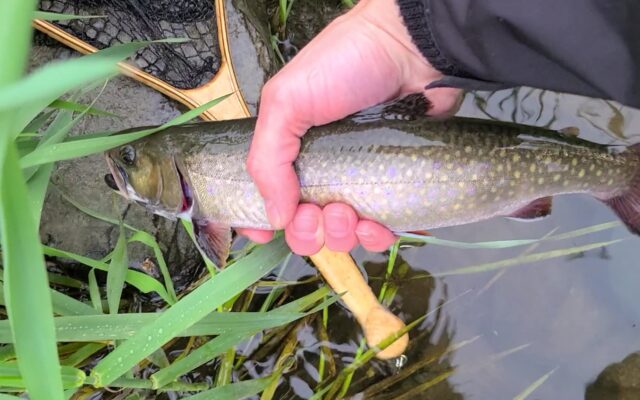
Aroostook County abounds with lakes, ponds, brooks and streams, but its namesake river
is an angler’s paradise for a few weeks each spring.
From its inception of creeks, springs and marshes near Munsungan, the Aroostook River wanders through dozens of towns and villages before exiting Maine into New Brunswick at Fort Fairfield. Most fishermen from the Crown of Maine can reach some portion of this tremendous trout stream with a 30-minute drive or less.
From mid-May to mid-June, steady brook trout action can be enjoyed while fishing from shore,
wading or from a boat. Casting bait, lures or flies all produce strikes and trolling is also
productive on many deeper runs until late summer heat saps the water levels. Trout average from 8 to 12 inches in length, but a lot of casters don’t realize how many trophy 16- to 20-inch speckled beauties swim about Aroostook River pools.
I really enjoy trolling from a canoe as long as early season water levels allow, and
experience steady action using lures and streamer flies. A ⅛- to ¼-ounce lure with
a monofilament 6 or 8 pound test line on a spinning or spin-cast rod and reel works well.
I prefer a 7½- to 9-foot rod for trolling lures and a 9-foot, 5-weight fly rod for trolling size 2, 4 and 6, 3X long, single-hook streamers. There are sporadic spring insect hatches that may be as short as 20 minutes or up to an hour at various spots along the river this time of year. To take advantage of such hatches, if you’re lucky enough to spot rising fish as you troll past, have a dry fly outfit rigged so it’s possible to anchor and cast.
My list of tried and true lures that seldom let me down when trolling any of the Aroostook
River runs include an Al’s goldfish, a pounded copper Mooselook wobbler, a Sutton spoon that’s
silver on one side and copper on the opposite and a Mepp’s spinner that’s yellow with red dots.
Favorite streamer flies include a Magog smelt, black and white bucktail, black-nose dace, gray
ghost and a supervisor.
Whether casting to trout that are rising to feed on hatching insects while wading or from a boat, I
recommend a size 12 or 14 hook on the higher water conditions.
Debris in and on the water surface is more common this time of year so apply a good dose of floatant to your fly to keep it riding high, offering a sharp surface silhouette. It’s hard to go wrong with dry fly patterns such as a Hendrickson, light Cahill, Henryville special, gray slim Jim, and a mosquito.

Wading and casting a fly along certain runs of the Aroostook River produces consistent action this month on hefty trout like this one being released to bite and fight again. (Courtesy of Bill Graves)
There’s a well-maintained boat launch just above the Caribou dam and consistently deep
water for trolling upstream toward Presque Isle. Even when hot weather and lack of rain saps
water levels in much of the river, this stretch is always favorable. Another excellent run for
trolling or floating and casting to trout feeding on hatches is just below the inlet of Little
Madawaska stream into the Aroostook River. A public ramp is located on the north side of the
river on Grimes Mill Road and another just off Route 161, the opposite shoreline, just across
from Main Siding Road. Both have obvious signage to pinpoint locations.
Upriver from the Fort Fairfield boat launch, near Hockenhull Brook inlet, are several
islands offering consistent fly fishing along the edges for trolling high water and wading as
levels decline.
Between Presque Isle and Washburn are a dozen productive pools that may be
reached by motoring upstream or down depending from which town you launch, or by parking
along Route 164 and walking less than 100 yards to the water’s edge. If anglers desire more remote runs and don’t mind an ATV drive or a rutted road two-track, start on the Wrightville Road or the Gardner Creek Road between Ashland and Washburn.
Crowding and over-fishing are seldom an issue on most of the Aroostook River that’s
More than a quarter mile from a boat launch, bridge or easy roadside access. With occasional rain, most of the waterway should be very productive through the end of June. After that, visit brook inlets and deep holes for best results.
Get out soon and often for great fun and fishing near home.







